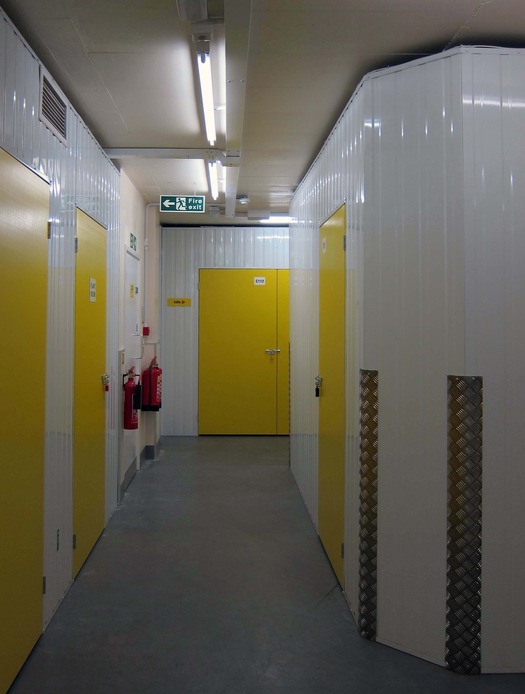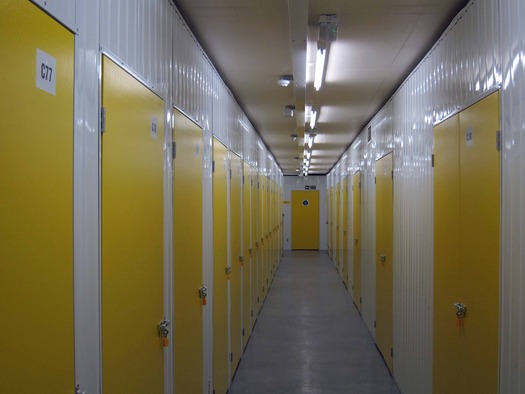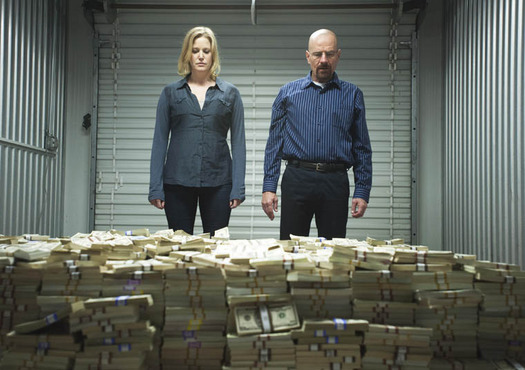
Standardized storage at The Big Yellow Storage Company in the UK. Photograph: Rick Poynor
I have had self storage envy for quite a while. I can be precise about the date. One evening in April 1995, I attended an installation by Laurie Anderson, Brian Eno and a team of collaborators from the Royal College of Art at the Acorn Storage Centre in Wembley, London. I had never been in a storage facility before and this was an extraordinary way to encounter one. Visitors followed a self-determined trail from unit to unit. The sound pieces by Anderson and Eno that the rooms contained, along with art works by Eno and others, were enjoyable, but it almost didn’t matter what we found inside. The best thing about Self Storage — an early project by Artangel — was the chance to wander freely in this strange space. Concealed receptacles no bigger than wardrobes! Cavernous hangars the size of a four-car garage! The unfathomable mystery of locked doors, unknown objects left, sometimes for years, in darkened repositories, and secret chambers that must remain off-limits to all but the key holder, if they are visited at all. From that day, I wanted a storage unit of my own.
At that point, though, I didn’t need one. It was only recently after a concerted attempt to de-clutter our house had produced a stubborn residue of things that were still wanted but not needed on a daily basis that we signed up for a modest unit at a local self storage center. I’m still setting everything up inside the space, which is already taking on some aspects of a room. There’s a swivel chair and I just put in the first of two, maybe more, sets of shelves as the most efficient way of accommodating magazine boxes. Some units have a void above with only a wire mesh to seal the unit, allowing someone to climb up and look down inside; we chose one with a solid ceiling. It’s oddly exhilarating to have an outpost like this, a satellite space for exclusively private use orbiting not far from home, though the experience is now commonplace. Self storage is big business and the chances are good, if you are a householder, that you have used the service at some time, too. The Big Yellow Storage Company. Photograph: Rick Poynor
The Big Yellow Storage Company. Photograph: Rick Poynor
The last time I visited, the corridor ceiling lights activated as I emerged from the elevator; I was clearly the only person on the floor. After I had finished, I wandered in the labyrinth of empty corridors, the lights clicking on as I went, past the hi-tensile steel wall panels and smooth yellow padlockable doors, round corners shielded from the blows of trolleys and boxes by tough steel checker-plate protectors. An alarm went off briefly for no obvious reason, making me feel like an intruder, though no one came to investigate. Some units in this recently opened section of the facility are already occupied, while many of these enticing voids still await their moment — one can tell from the presence of the company’s default lightweight padlock. The center uses an off-the-peg corridor and door system available throughout Europe, Asia, Australasia, and the Middle East. The blank physical parts of this standardized kit could not be more matter of fact and, on the face of it, less eerie or conducive to mystery, a far cry from the grimy, decaying self storage unit behind the old shutter that won’t open properly, under which FBI Academy student Clarice Starling must slide in The Silence of the Lambs.
In films and TV programs, the self storage unit has become a regular site of wrongdoing, a place to conceal the tools, proceeds and evidence of crime, a location of disturbance, violence and unease. Opposite the elevator at my facility, there’s a warning sign showing graphic red images of a gun, a flame, dripping acid and an exploding bomb. The list of prohibited items includes firearms, munitions, toxic, flammable or hazardous goods, illegal goods, cash and securities. Tell that to Walt and Skyler White in the cult TV series Breaking Bad. In what might just be the greatest ever scene set in a storage unit, a truly chilling moment in episode 8 of the fifth season, Skyler shows Walt the ever-accumulating fruits of his criminal genius — an obscenely vast edifice of dollar bills as implacably “there” and undeniable as a Carl Andre sculpture built of bricks. In this shuttered and secluded private theater, it feels uncomfortably like we, the viewers, are being made privy to our own unacceptable longings.
 Skyler and Walt visit their unit in Breaking Bad. Photograph: Lewis Jacobs/AMC
Skyler and Walt visit their unit in Breaking Bad. Photograph: Lewis Jacobs/AMC
The hidden realm of the storage unit releases inhibitions and encourages crazed flights of fantasy. It can be a site of marital double-cross and revenge (Self Storage), alien-on-the-rampage sci-fi hokum (Storage 24), or visceral horror, as in the forthcoming Self Storage — tag line: “Safe. Secure. Psychotic” — starring Eric Roberts. If the trend is going to continue, they clearly need some better titles. Filmmakers should also stop playing fast and loose with the structural limitations of the setting: storage units tend not to be connected by crawlspace-sized air vents allowing people to move freely from one unit to another. It’s about security, people. That said, the earlier Self Storage, a 17-minute short, has an audacious and just about believable structural twist.
